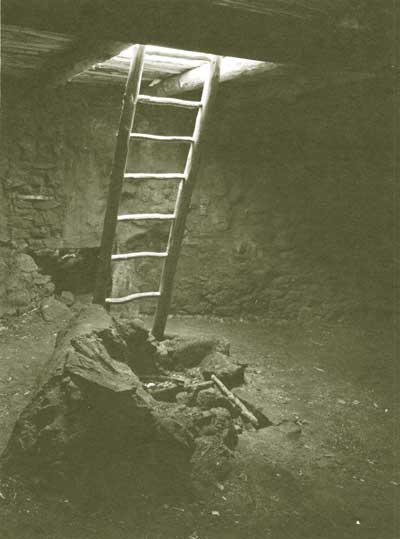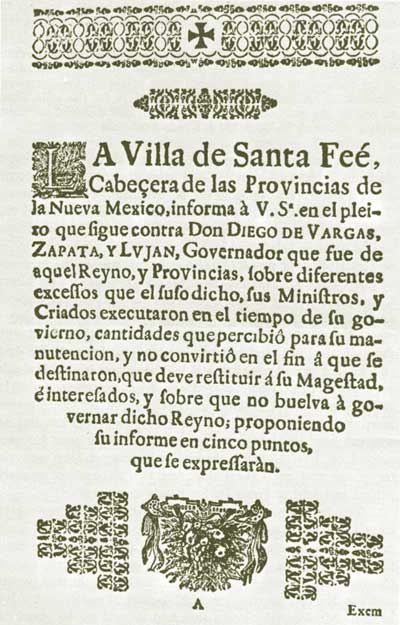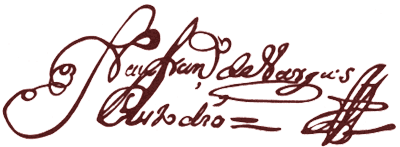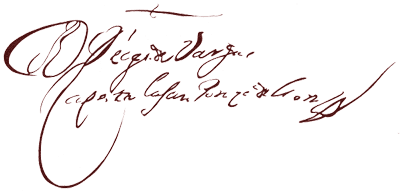

Contents Foreword Preface The Invaders 1540-1542 The New Mexico: Preliminaries to Conquest 1542-1595 Oñate's Disenchantment 1595-1617 The "Christianization" of Pecos 1617-1659 The Shadow of the Inquisition 1659-1680 Their Own Worst Enemies 1680-1704 Pecos and the Friars 1704-1794 Pecos, the Plains, and the Provincias Internas 1704-1794 Toward Extinction 1794-1840 Epilogue Abbreviations Notes Bibliography |
Revolt of 1696 The blow the "fearful Franciscans" expected, but Diego de Vargas did not, fell Monday, June 4. In the Jémez, Tewa, Tano, and Tiwa pueblos of the north, it was August 10, 1680, all over. The vengeful Pueblos ran amuck. Spanish settlers, twenty-one in all, were denuded and put to death and their bodies strewn about. At San Ildefonso, rebels fired the church and convento with Fathers Francisco Corvera and Antonio Moreno inside. Near the convento of twice-relocated San Cristóbal, they tossed the bodies of two more Franciscans, partially stripped, face up grotesquely, in the form of a cross. At San Diego de los Jémez, the Indians called Father Francisco de Jesús María Casañas to confess a dying woman. It was a ruse. Clubbing him dead, they threw the body at the church door where wild beasts later consumed much of it. Thus Casañas, one the Queretarans who stayed, gained a place in his Order's martyrology as protomartyr of the Propaganda Fide colleges in North America. [52] Not so widespread or so costly in terms of body count as 1680, still, this second revolt would take Diego de Vargas six months to suppress, six trying months of skirmishes, of destruction and theft of crops and animals, of executions and offers of pardon, of Pueblos shifting for survival. The Keres of San Felipe, Santa Ana, and Zia stuck with the Spaniards, as did most of the Tewas of Tesuque. Neither did the Pecos revolt. Again, as in the reconquest, Pecos auxiliaries served alongside the Spaniards on almost every campaign. Yet the Pecos were divided, worse than usual. For the first time, Spaniards recorded the violence of factionalism at Pecos. The pueblo was about to split wide open. The first excited reports said the Pecos had risen. Confident that they were wrong, Governor Vargas dispatched orders to Alcalde mayor Francisco de Anaya to evacuate the missionaries and come on the double to Santa Fe with one hundred loyal Pecos warriors. Anaya arrived during the night of June 5 with the two remaining Queretarans, Fray José García Marín, who had just replaced Father Alpuente at Pecos, and Fray Miguel de Trizio of San Juan de los Jémez, who, lucky for him, was at Pecos nursing García. Next day, don Felipe Chistoe, governor of the Pecos, appeared with his war captains and the one hundred auxiliaries, some mounted and some afoot. Vargas had been right. [53] To verify the carnage in the nearest Tewa pueblos, the governor made a quick two-day inspection taking his aides, twenty soldiers and armed civilians, Alcalde mayor Anaya, don Felipe, and the one hundred Pecos. At Nambé the hard-bitten Fray Juan Alpuente, again chaplain, officiated at the burial of victims. To bury the dead friars at San Ildefonso pueblo, Vargas called for the Pecos Indians and the soldiers "to cover them with a wall and adobes the rebels had torn down from the church itself for the reason that they could not be moved because they were whole. The fire had not burned them, but rather the smoke and heat suffocated them because the enemy Indians had cut off the ventilation." [54] A Terrible Plot at Pecos Back in Santa Fe, the cooperative Felipe Chistoe of Pecos, who was not among the nineteen pueblo officials installed by Vargas twenty months before, came to don Diego in confidence with a dreadful scheme. He wanted the royal governor's sanction. The faction at Pecos headed by Diego Umbiro, "old and principal personage of this nation," had been cooperating with the rebels "by treaty and council." Cachina, a war captain with a large following, and two other prominent Pecos were also among the leaders plotting the Spaniards' overthrow. What don Felipe wanted was license to execute them.
Two days later, Monday, June 11, the arrival at Pecos of two rebel agitators played into don Felipe's hands. One of them, a Jémez called Luis Cunixu, flaunted "an eight-sided gilded brass reliquary containing various relics, among them a piece of wood of the cross and an ecce homo [literary, 'behold the man,' an image of Christ, scourged, crowned with thorns, wearing a red robe, and holding a reed in His bound hands]." It had belonged to Father Casañas, who was now dead, the Indian bragged. The other rebel, Diego Xenome of Nambé, had allegedly spent the entire winter traveling from pueblo to pueblo, even to Zuñi and Hopi and the Apaches, spreading the gospel of revolt. Don Felipe knew they had come to enlist the Pecos. He pretended to go along with them. As governor of the pueblo, he bade the rebel emissaries, their principal Pecos sympathizers, and enough trusted members of his own faction to enter a kiva. What he was about to do in the close, semi-darkness of the kiva that day would have repercussions that not even he could anticipate. He asked the principales of the opposing faction what they thought of the uprising. Diego Umbiro spoke for them. To kill the Spaniards, Umbiro said, was good. Spaniards were, after all, "of different flesh." The people who had revolted were Indians like they, the Pecos. "And the rest of his following, Cachina and the others, answered in like manner." Executions in a Pecos Kiva Then don Felipe made his move. Getting up from where he sat and brandishing his pueblo governor's staff, he announced with gravity, "Here we are the king's men!" With that, his followers seized the five principal men of the opposition. They hanged Diego Umbiro, Cachina, and two others. The fifth, a youth "who was gaining a following" among the Pecos, got away. The deed was done. Next day don Felipe turned Luis Cunixu and Diego Xenome over to Governor Vargas. They told their stories and were shot. [55] Despite this terrible show of "loyalty," Father Custos Vargas did not trust the Pecos. What if they had given warnings in 1680 and spared Father Velasco: they would not deny the murders of Fray Juan de la Pedrosa and a Spanish family. They just kept silent.
Church Possessions Removed Why risk it, the prelate asked the governor. This time Diego de Vargas heeded the alarmist friar and provided the guard, mules, and muleteers to remove everything of value from Pecos. He sent Alcalde mayor Anaya to raise eighty Pecos warriors for the next campaign and "to tell these Indians in advance that the provisions and sheep, as well as the religious objects, were being removed only to secure them from attack by rebels or by Apaches allied with the rebels." Father Antonio de Acevedo, guardian of the Santa Fe convento, rode down to Pecos with the pack train on Saturday, July 7, said Mass at the pueblo early next day, and was back in the villa with provisions, sheep, and religious gear about two o'clock Sunday afternoon. [56] Ten days later while Anaya was at Pecos preparing the auxiliaries Governor Vargas had requested, a Pecos lad ran up to him saying that a crowd of rebels was in the mountains only two leagues away. They were Taos, Picurís, and Tanos coming to assault Pecos. They were afoot. Anaya wrote Vargas immediately asking for powder and ball. Vargas sent it. He thought the rebels might steal the Pecos horses and ride on Santa Fe. He postponed his campaign. But the threat vanished. The rebels turned back for Taos. Anaya saw their tracks and the signs they had drawn in the dirt on the trail, which his Pecos interpreted for him.
Whatever his motives—and they may have sprung from a purely Pecos grudge or from personal ambition akin to that of El Popé—don Felipe Chistoe pursued his purge of the opposition with deadly vengeance. When he learned that Pock Face (Caripicado), the youth who escaped the hanging, had ventured back into the pueblo under the cover of night, he loaded his arquebus and went looking for him. When he caught sight of him at a distance he fired. The ball entered the temple. Pock Face fell dead. To prove that he had killed the rebel, don Felipe took his retinue and went up to Santa Fe with trophies. Governor Vargas entered the Indian's arrival in his journal for August 30, 1696.
Rebuilding The provisions packed up on muleback from Pecos in July had saved the day for Custos Vargas and the nine refugee friars crowded into the convento at Santa Fe. By August, the prelate had quit griping at Diego de Vargas and gone back to his mission at Santa Ana. The governor, passing through that pueblo on his return from a stand-off before the great rock of Ácoma noted the progress Father Vargas had made on his building project. He had finished a convento and had amassed the materials, the adobes and timbers, for construction of the church. "He had brought the carpenters of the pueblo of Pecos to hasten working these timbers and likewise the doors, which he specified and the carpenters took the measurement in order to make." Again the carpenters of Pecos were in demand, as they would be throughout the eighteenth century—carpenters and native auxiliaries. Custos Francisco de Vargas, the friar who had expressed such vehement distrust of the Pecos two months before, in September went to their pueblo himself to supervise a remodeling of the temporary church that Zeinos had built. Diego de Vargas, meanwhile, campaigned against the Taos with his usual contingent of Pecos. Late in October, they chased down some of the Picurís who were fleeing eastward with Apaches across the mountains. Fatigued and half-frozen, the royal governor and his advance party made it back to Pecos on November 7 after eleven days of driving snow and sleet. The prelate and the governor embraced. There were no harsh words at this meeting. Don Diego was made welcome over chocolate in the convento. The priest explained that he had celebrated the feasts of All Saints and All Souls, November 1 and 2, in the enlarged Pecos church. Governor Vargas of course complimented him on the splendid job he had done.
Diego de Vargas Replaced The Pueblo revolt of 1696 had backfired. By forcing a decision in Mexico City, it had strengthened the Spaniards' hand. New Mexico must never be evacuated again, whatever the cost. Another such humiliation of Spanish arms and the whole northern frontier might rise. Therefore, the precarious colony must be reinforced with more settlers, provisions, tools, and livestock. The revolt of 1696 not only assured the presence of many more Spaniards in New Mexico, but also by its failure to attract all the Pueblos, it crushed forever the prospect of another 1680. Through crisis after crisis Diego de Vargas had ruled with the iron fist that circumstances seemed to demand. He had effectively muzzled criticism and had broadcast his noble deeds as far as his name would carry them. When the crown failed to reward him with a promotion, he bid for a second five-year term as governor and captain general of New Mexico. But he was too late. His replacement, don Pedro Rodríguez Cubero, arrived on July 2, 1697, thereby unleashing a local struggle for power and preferment that saw the reconqueror crudely vilified and held in Santa Fe for nearly three years. [60] The Franciscans, meanwhile, played the local factions to whatever advantage they could and gradually restored their missions. Straight-away Rodríguez had a proper convento built for them in Santa Fe. The viceroy approved the request of Custos Vargas raising the number of friars from thirteen priests and one lay brother, the low ebb, to twenty priests and a lay brother. Missions like Pecos that had slipped to the status of visitas were again staffed with resident missionaries. Other friars, fired by the old zeal, braved considerable hostility to entrench themselves again on the rock of Ácoma and at Zuñi. At Laguna, they founded an entirely new mission for a congregation of Pueblo displaced persons. They even ventured as far as the Hopi pueblos, but there they failed. When the people of Awatovi showed themselves ready to receive the Spaniards back, the others, evidently motivated by an old intratribal grudge, annihilated that pueblo. At Pecos, a parade of at least half a dozen friars administered the mission between 1697 and 1700. From the bunching of their entries in the book of baptisms, it would appear that they spent a goodly portion of their time in the relative security of Santa Fe, venturing out to Pecos only when the occasion or the spirit moved them, a practice observed, for better or for worse, during much of the eighteenth century. When Fray Juan Álvarez, the new custos, made his visitation of Pecos on November 5, 1697, he found everything in order, almost. He told Fray Alonso Jiménez de Cisneros, who had been in charge since March, to sign the account book in receipt of the mission's movable assets. He reminded the missionary that "with regard to these and all other things the maximum growth of the missions is a religious and Christian obligation, both in the realm of the spiritual and in the other." [61]
The Pecos as Their Own Worst Enemies Almost independent of the daily round observed in church and convento, a grim struggle gripped the pueblo only a few hundred feet away. The memory of don Felipe Chistoe's executions in the summer of 1696 had set Pecos against Pecos. The families and clans of Diego Umbiro, of Cachina, and of Pock Face did not forget. Toward the end of the year 1700, the enemies of don Felipe tried to incite the entire pueblo to rise up and kill him. Failing that, they made known their hatred in other ways, openly committing acts of grave disrespect toward him, even in the presence of their missionary and the alcalde mayor. Fearing further violence, the alcalde mayor notified Governor Rodríguez Cubero. The governor had the ringleaders arrested and hauled up to the Santa Fe jail. But they soon broke out and fled to the Jicarilla Apaches. The struggle continued at Pecos. On at least five different occasions, the two factions stood at the brink of civil war. Each time don Felipe prevailed. Fearing ruin if the final rupture came, the leaders of the opposing faction petitioned Governor Rodríguez Cubero to let them move to the deserted Tewa pueblo of Pojoaque. For some reason, he must have denied their petition, for in 1707 Pojoaque was resettled by "Tewas." Like don Lorenzo de Ye, the principal opponents of Felipe Chistoe seemed simply to disappear. Some may have taken up with Apaches or gone with their families to live in other pueblos. Still, their removal cannot have healed so deep a rift. [62]
Don Felipe endured. In the early spring of 1702, he headed a Pecos delegation summoned to Santa Fe by Governor Rodríguez Cubero. The Tewas and Taos were reported plotting revolt again in league with Apaches. The Pecos governor, who was described as about forty years old, gave his testimony in Spanish and interpreted for the others but could not sign. He assured the royal governor that the Pecos were quiet and peaceful. No pueblo had invited them to rebel. They had learned from some "Apaches de la Trementina," which means in Spanish the Turpentine Apaches, that the Tewas and Taos wanted Trementinas and Jicarillas to help them kill the Spaniards. The Apaches had refused because the Spaniards were the source of "what they needed, such as horses, knives, hoes, and other goods." [63] The Death of Diego de Vargas Felipe Chistoe was there in 1704 when Diego de Vargas died. Vargas, who finally got away from Rodríguez Cubero, had vindicated himself and returned to New Mexico as the Marqués de la Nava Braziñas for a second term as governor. Still the nobleman on horseback, the sixty-year-old Vargas proclaimed a campaign against the Faraón and Siete Ríos Apaches. Leading his troops through the Río Abajo, the reconqueror fell ill. They carried him back as far as Bernalillo. There on April 8, he died. Don Felipe, governor of the Pecos, had headed the list of Pueblo auxiliaries on Vargas's last campaign. He had brought Pecos war captains Miguel, Diego, Pedro, and Agustín and forty-two fighting men, many more than had come from any of the other pueblos. By his actions in the revolt of 1696, Felipe had firmly committed the Pecos to an alliance with the Spaniards. It was an alliance that long outlived him, one that lasted as long as there were Pecos able to fight. [64]
The fatal rift at Pecos, betrayed only vaguely in the years before, broke wide open under the stress of revolt and reconquest. Pecos turned on Pecos. None would forget the executions of 1696. For whatever reasons, some had committed themselves to the Spaniards' presence—at a later date they would have been styled Progressives—while others—the Conservatives—resisted it just as grimly. Rent from within, shaken by don Felipe's purge, the fortress at the gateway between pueblos and plains stood less firm before the Comanches and the epidemics to come. | ||||||
 Top Top
|
| ||||||






